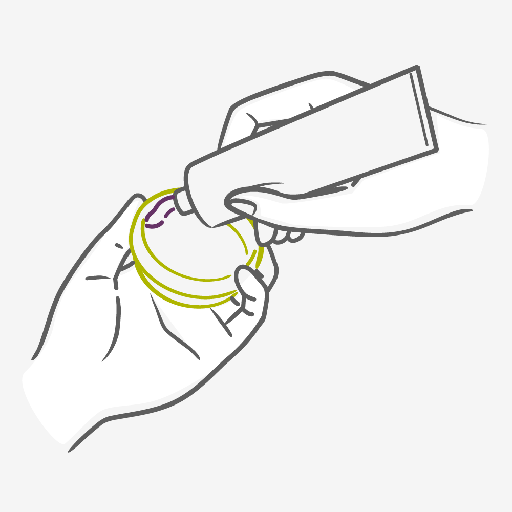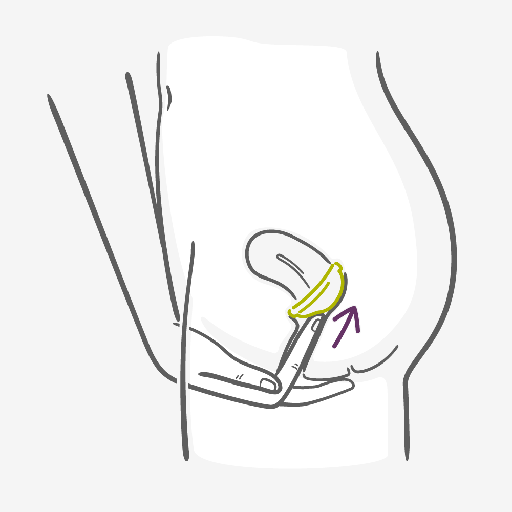DIAPHRAGM
WHEN and HOW?
You must put the diaphragm into the vagina before having sex. The diaphragm has an efficacy of 83% with tyical use.
How to use a contraceptive diaphragm?
- Start by washing your hands.
- Fill the diaphragm up with spermicide and spread some around the edges too just to be safe.
- Now, act like you’re about to put in a tampon, fold the diaphragm in half and slide it up into your vagina and then push it right up until it’s covering your cervix.
- Leave it in for at least 6 hours after sex and don’t leave it in for more than 24 hours in total.
The great thing is that you can be organized, or last minute, it’s up to you; insert hours before or just before sex. The diaphragm can be left in place for up to 24 hours.
If you have sex more than once you need to use more spermicide every time you have intercourse. The only rules are, leave it in for at least 6 hours after sex and don’t leave it in for more than 24 hours in total. From time to time, check the diaphragm for any damages and replace it if necessary. You should also have the diaphragm checked after childbirth or if you lose more than 15 pounds as you might need to use a different size.
Tabs header
Diaphragm PROS:
- It can be used on demand
- It can easily be carried with you
- It isn’t affected by other medications
- It can be used when breastfeeding
- Hormone free
- Low cost
Diaphragm CONS:
- Using it can take practice
- It requires keeping track of the hours inserted
- Not always suitable for women who have given birth
- Needs spermicide to be fully effective
- It can interfere with spontaneity
- It requires initial fitting by healthcare provider
- It may cause irritation, allergic reactions, and urinary tract infection
- If you keep it in place longer than 24 hours, there is a risk of toxic shock syndrome. Toxic shock is a rare but serious infection
- Does not protect against HIV infection (AIDS) and other sexually transmitted infections (STIs)
All important details about the Diaphragm
The diaphragm is a simple tool, it looks like a tiny hat and it just stands in the way stopping any sperm from getting anywhere near your uterus. The dome-shaped flexible disc has a flexible rim and is made from latex rubber or silicone. It is inserted into the vagina to form a barrier between the sperm and the entrance of the woman’s womb. Your healthcare provider will need to do an initial fitting to find the right size diaphragm for you.
It doesn’t get its efficacy rate alone though, it is highly recommended to combine it with spermicide and that’s when the method really comes into its own.

Questions & Answers about the Diaphragm
FREQUENTLY ASKED QUESTIONS
Most spermicides spermicides have an unpleasant taste but will not usually harm you or make you feel ill, however it is advisable to avoid swallowing excessive amounts. If you are concerned about feeling ill following swallowing some spermicide, you should seek the advice of a healthcare provider.
Spermicides contain substances that kill sperm. Some products also form a thick foam or mucus which blocks the cervix and acts as a barrier against the sperm. They can come in the form of foam, foaming tablets, pessaries, creams, jellies and sponges. Spermicides are not effective enough when used alone, and should be used in combination with barrier methods such as the diaphragm or cervical cap.
There is no reason for the diaphragm to get lost or stuck inside your body. A diaphragm will be specifically fitted by a healthcare provider to ensure it fits and can be used effectively by you. If you are having a diaphragm fitted, you should practice insertion, placement and removal with the healthcare provider. The diaphragm should also be checked every six months by a healthcare provider to make sure it still fits properly.
A pelvic examination by either a physician or a skilled healthcare provider is required for fitting diaphragms. Fitting rings are produced by diaphragm manufacturers in various sizes and with different rim types. Sizes range from 50 to 105 mm. They are most commonly available in flat spring or coil spring rim types. Diaphragms between 60 -85 mm in diameter will provide the correct fit for most women. Initially the fitting ring size is estimated by clinical assessment of the vaginal length. Smaller or larger sizes are then inserted until the correct fit is achieved. It is important that each individual is fitted with the type of rim that she will ultimately use as the rim type can affect fit and ease of insertion. It should fit snugly into the upper half of the vagina. The user should practice insertion under supervision and placement should be inspected to ensure that the fitting ring is correctly positioned in the vagina. Fitting is best done when the bladder is not empty so that the user can test to ensure that urination is easily accomplished with the selected fitting ring in place. The diaphragm may require resizing following a full-term pregnancy, pelvic surgery, or abortion, or if there is a major change in weight.
The diaphragm can be inserted immediately before or up to 6 hours before intercourse. Some people do find that this might interfere with spontaneity.



































